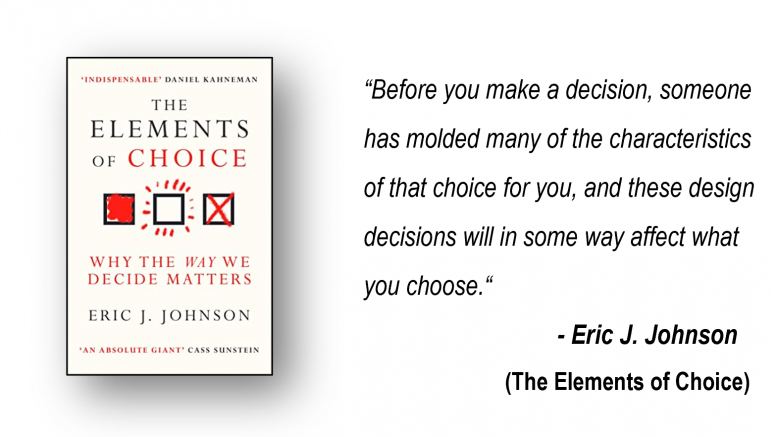Have you ever wondered why you chose a particular option? What made you choose that lipstick shade or laptop or phone brand? What motivates us to choose one option over another?
The process of decision making may seem intense or simple, but we seldom realise how we were influenced by the external factors during that time. How others help you make that choice, pick that phone or buy that lipstick, intentionally or unintentionally. But one does not realise that we have someone partnering with us on that decision making process. The book ‘The Element of Choice’ takes a close look at exactly how the way choices are presented can change the decision-making process. Though we agree that someone is playing that role in influencing our decision, but we will not be completely aware that there is a systematic approach on the decision-making process in our life.
What does the book cover?
“The way choices are posed affects our actions” states the author, Eric Johnson in the book which is divided into 10 chapters. We make different choices at different stages of life or options that are available that would suit our need at that time or later, such as retirement plans or what would you prefer to eat now. These are part of ‘Choice architecture’, as defined by the author, “The many aspects of how a choice is posed that can be manipulated, intentionally or inadvertently, to influence the decisions we make. The options may be the same, but the presentation can change your choice”. And the people who present those choices like the doctors, or the seller are the ‘Choice architects’ -They are the designers of the decision that we make. The choice architects are designers and the people who make decisions are the choosers. Hence, before you decide, someone has already molded the characteristics of the choice and the ‘design decisions’ will in some way affect what you choose.
Three takeaways
Decision by default: When you choose by default, you make the decision more quickly. It is possible for someone to not engage in a decision if they choose the default option. However, understanding defaults depends on understanding endorsements and endowments, which are both channels through which preferences are assembled.
Describing Options: Choosing the right metrics is at the heart of design of choice architectures. Designers might strive hard to make sure they present accurate information, but like choosers, they might not comprehend those minor changes could have quite a big impact on choices.
Becoming Better Choice Architects: A designer has an immense influence on the chooser; however, a designer should design the choice architecture as they would want it for themselves. As good Choice Architecture can help address critical issues. Especially, the issues related to Climate Change, Inequity and Polarisation and fake news.
What’s in it for me?
There are some unique concepts in the book that takes an interesting approach to decision making. Since we work in a field where decisions and recommendations are made on the go, it was interesting to learn how one could manoeuvre the decision-making process in one’s favour and turn it to our advantage by using choice architecture.
My recommendation
The concept of Choice Architecture is cleverly articulated with examples and anecdotes that are easy to relate to. The book offers different tools for the designers. If you take your time and read this one at leisure with concentration, you will learn a lot about decision making for different stake holders at different stages in life.
The views and opinions published here belong to the author and do not necessarily reflect the views and opinions of the publisher.



Be the first to comment on "The Elements of Choice"